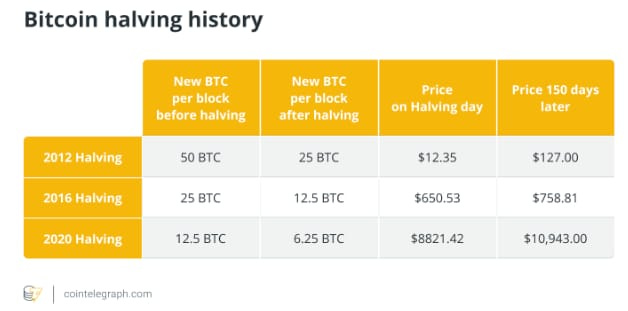You are gonna hear A LOT about Bitcoin this year
Also how to overcome Parkinson’s Law.
Bitcoin crossed $61,000 this morning and is on its way to an all time high. Oh what a time to be alive! In this newsletter, I’ll go into why it is surging and then I’ll shift gears into topics like how to learn and how to get things done. Happy reading.
On Technology
I am not a crypto bro, I promise. But I am fascinated by Bitcoin (BTC). Whether you think it is all a scam or believe that crypto is the future, either way, you should know about the Bitcoin halving. It is coming in 50 days, and it's a pretty big deal.
What is the halving?
Simply put, Bitcoin halving reduces the pace at which new bitcoins enter circulation by half. The halving is a feature written into the code by Satoshi Nakamoto, Bitcoin’s pseudonymous creator. It's designed to regulate Bitcoin's supply and ensure the steady, controlled introduction of new bitcoins into the system. In theory, slowing down the rate at which new bitcoins are issued should lead to a price increase if the demand stays constant.
The halving, which occurs just about every four years, has so far decreased the reward for mining a block to 25 BTC on November 28, 2012, then to 12.5 BTC on July 9, 2016, and most recently to 6.25 BTC on May 11, 2020. This rewards system will continue until about 2140, when the proposed limit of 21 million coins is reached.
But why does it have to halve?
Halving serves different purposes:
Inflation Reduction: By decreasing the rate at which new bitcoins are generated, the halving event reduces the rate of inflation over time. This is intended to increase the value of Bitcoin as its scarcity increases.
Incentive for Miners: Initially, miners are incentivized to secure the network by the block rewards. As these rewards diminish over time, transaction fees are expected to become a more significant part of the reward, ensuring that miners are still incentivized to process transactions even after the last Bitcoin is mined.
Controlled Supply: Again, Bitcoin has a capped supply of 21 million coins. The halving ensures that the total number of bitcoins doesn't exceed this limit.
Why you should care?
It’s fascinating. Every four years, Bitcoin becomes a very newsworthy event. This will be something people are talking about in 2024 and 2025. At the very least, having a primer on it makes you seem interesting at parties.
It could be an investment opportunity. Historically, the halving has led to notable price surges in the months that follow. While that’s not an explicit aim of the halving, the trend has been for prices to climb significantly, primarily because the supply of new bitcoins diminishes while demand remains steady or grows. Platforms like Coinbase and Paypal make it easy to invest. So, you might be able to make some money out of all this.
Bitcoin might be too large to ignore. The market capitalization of digital assets, now sitting at over $2 trillion, surpasses the GDP of many countries. While the total number of people who own Bitcoin is still small, it is growing. And, we are in uncharted waters with the U.S. Securities and Exchange Commission (SEC) approving 11 spot bitcoin ETFs in January . More and more scarcity should continue to reinforce Bitcoin’s status as a store of value and a hedge against monetary inflation.
In conclusion
It is important to note that this is not financial advice. This newsletter is written for entertainment purposes only. And Bitcoin and cryptocurrency as a whole are very volatile. Just because history has a history of repeating doesn’t mean it will again. Long story short, this should all be taken with a grain of salt, as the cryptocurrency market is known for its unpredictability.
But…
One of Bitcoin’s key features is scarcity. Scarcity makes Bitcoin anti-inflationary, unlike fiat currencies. And the dream here is that Bitcoin becomes a powerful global store of value. At the very least, it promises to be quite a spectacle to behold
On Productivity
Cyril Northcote Parkinson, a British naval historian and author, introduced this observation in a 1955 essay for The Economist with the opening line, 'Work expands so as to fill the time available for its completion.' This adage means that a task will take as long as the time one allocates for it, regardless of its complexity. Schedule a meeting for an hour, and it will last an hour. Allocate a whole day to clean your house, and it will take the entire day. Have a week to finish a project? It will fill that week.
Work can expand if you let it. Here are a few tips to overcome Parkinson’s Law:
Awareness. The first step in solving any problem is identifying it. Being aware of the potential to succumb to Parkinson's Law can aid in steering clear of its pitfalls.
Control Time. Shift your thinking from "how much time do I have?" to "how much time do I realistically need?" for each task and set your deadlines based on that assessment. For example, you might end up scheduling your next meeting for 30 minutes instead of an hour.
Stop the Scope Creep. Understand your project's requirements clearly and prioritize tasks and activities based on their urgency and importance. Not every task has the same level of significance. Tackle those high-priority tasks first.
Try Timeboxing. Timeboxing is a time management technique where you allocate a fixed, limited amount of time to a specific activity. You work on the task for that period and then stop once the time is up.
Work within designated time intervals. Similar to Timeboxing, these intervals could range from a brief 25-minute session, similar to the Pomodoro method (more on this in future newsletters), to up to 90 minutes. No longer though. Research suggest that the brain's focus tends to diminish after 90 minutes. So make sure you take at least a 15-minute break.
Parkinson's Law has stood the test of time, continuing to resonate in today's discussions. It’s not so much a law, but rather an observation of human behavior, but it highlights the need to set realistic deadlines and constraints.
Ever forward.
— Derek (aka Chief Rabbit)
Enjoying Chief Rabbit?
This newsletter is free and always will be. But if you’d like to support this work, you can. You’ll get monthly Q&As, vote on topics, stickers, and help keep this ad-free.
You can also follow me on Threads where I sound off on all sorts of nonsense OR LinkedIn where I tend to be a touch more serious.
Also, thanks for being someone who reads to the bottom of the page, you’re a special human.





Ha! Love that you combine Bitcoin+ scarcity. Read about it yesterday in combination with Taylor Swift's era tour.
I think it's highly hyped and scarcity is a huge part of its overall marketing.